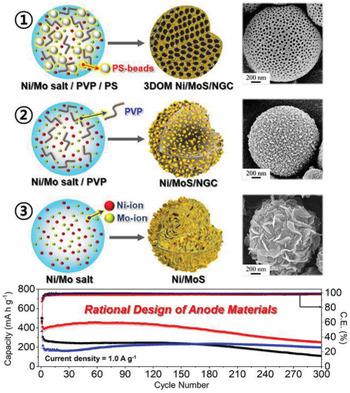当前位置:
X-MOL 学术
›
Small Methods
›
论文详情
Our official English website, www.x-mol.net, welcomes your
feedback! (Note: you will need to create a separate account there.)
Rational Design of Perforated Bimetallic (Ni, Mo) Sulfides/N-doped Graphitic Carbon Composite Microspheres as Anode Materials for Superior Na-Ion Batteries
Small Methods ( IF 10.7 ) Pub Date : 2021-07-28 , DOI: 10.1002/smtd.202100195 Jae Seob Lee 1 , Rakesh Saroha 1 , Se Hwan Oh 1 , Dong Hyeok Shin 1 , Sang Mun Jeong 2 , Jae-Kwang Kim 3 , Jung Sang Cho 1
Small Methods ( IF 10.7 ) Pub Date : 2021-07-28 , DOI: 10.1002/smtd.202100195 Jae Seob Lee 1 , Rakesh Saroha 1 , Se Hwan Oh 1 , Dong Hyeok Shin 1 , Sang Mun Jeong 2 , Jae-Kwang Kim 3 , Jung Sang Cho 1
Affiliation

|
Highly conductive 3D ordered mesoporous Ni7S6-MoS2/N-doped graphitic carbon (NGC) composite (P-NiMoS/C) microspheres are prepared as anode materials for Na-ion batteries. The rationally designed nanostructure comprises stable Ni7S6- and MoS2-phases along with the homogeneously distributed ordered mesopores (ϕ = 50 nm) over the external and internal structures generated through thermal decomposition of polystyrene nanobeads (ϕ = 100 nm). Therefore, the P-NiMoS/C microspheres deliver initial discharge capacities of 662, 419, 373, 300, 231, 181, and 146 mA h g−1 at current densities of 0.5, 1, 2, 4, 6, 8, and 10 A g−1, respectively. Furthermore, P-NiMoS/C exhibits a stable discharge capacity of 444 mA h g−1 at the end of the 150th cycle at a current density of 0.5 A g−1, indicating higher cycling stability than the filled, that is, non-mesoporous, Ni3S2-MoS2/NGC (F-NiMoS/C) microspheres and filled carbon-free Ni3S2-MoS2 (F-NiMoS) microspheres. The superior electrochemical performance of P-NiMoS/C microspheres is attributed to the rapid Na+ ion diffusion, alleviation of severe volume stress during prolonged cycling, and higher electrical conductivity of NGC, which results in fast charge transfer during the redox processes. The results in the present study can provide fundamental knowledge for the development of multicomponent, porous, and highly conductive anodes for various applications.
中文翻译:

多孔双金属(Ni,Mo)硫化物/N掺杂石墨碳复合微球作为优质钠离子电池负极材料的合理设计
制备了高导电性 3D 有序介孔 Ni 7 S 6 -MoS 2 /N 掺杂石墨碳 (NGC) 复合材料 (P-NiMoS/C) 微球作为钠离子电池的负极材料。合理设计的纳米结构包括稳定的 Ni 7 S 6 - 和 MoS 2 - 相以及通过聚苯乙烯纳米珠(φ = 100 nm)的热分解产生的外部和内部结构上均匀分布的有序介孔(φ = 50 nm)。因此,P-NiMoS/C 微球在 0.5、1、2、4、6、8 和 10 的电流密度下提供 662、419、373、300、231、181 和 146 mA h g -1 的初始放电容量克-1, 分别。此外,P-NiMoS/C在第 150 次循环结束时在 0.5 A g -1的电流密度下表现出 444 mAh g -1的稳定放电容量,表明循环稳定性高于填充材料,即非介孔, Ni 3 S 2 -MoS 2 /NGC (F-NiMoS/C) 微球和填充的无碳 Ni 3 S 2 -MoS 2 (F-NiMoS) 微球。P-NiMoS/C 微球优异的电化学性能归因于快速的 Na +离子扩散,在长时间循环期间减轻严重的体积应力,以及 NGC 的更高电导率,这导致氧化还原过程中的快速电荷转移。本研究的结果可以为开发用于各种应用的多组分、多孔和高导电性阳极提供基础知识。
更新日期:2021-09-14
中文翻译:

多孔双金属(Ni,Mo)硫化物/N掺杂石墨碳复合微球作为优质钠离子电池负极材料的合理设计
制备了高导电性 3D 有序介孔 Ni 7 S 6 -MoS 2 /N 掺杂石墨碳 (NGC) 复合材料 (P-NiMoS/C) 微球作为钠离子电池的负极材料。合理设计的纳米结构包括稳定的 Ni 7 S 6 - 和 MoS 2 - 相以及通过聚苯乙烯纳米珠(φ = 100 nm)的热分解产生的外部和内部结构上均匀分布的有序介孔(φ = 50 nm)。因此,P-NiMoS/C 微球在 0.5、1、2、4、6、8 和 10 的电流密度下提供 662、419、373、300、231、181 和 146 mA h g -1 的初始放电容量克-1, 分别。此外,P-NiMoS/C在第 150 次循环结束时在 0.5 A g -1的电流密度下表现出 444 mAh g -1的稳定放电容量,表明循环稳定性高于填充材料,即非介孔, Ni 3 S 2 -MoS 2 /NGC (F-NiMoS/C) 微球和填充的无碳 Ni 3 S 2 -MoS 2 (F-NiMoS) 微球。P-NiMoS/C 微球优异的电化学性能归因于快速的 Na +离子扩散,在长时间循环期间减轻严重的体积应力,以及 NGC 的更高电导率,这导致氧化还原过程中的快速电荷转移。本研究的结果可以为开发用于各种应用的多组分、多孔和高导电性阳极提供基础知识。










































 京公网安备 11010802027423号
京公网安备 11010802027423号